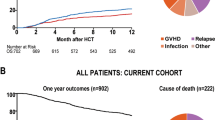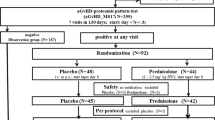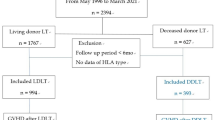Abstract
Danger-associated molecular patterns (DAMPs) are molecules that can initiate and maintain robust inflammatory responses and were investigated in the pathogenesis of graft versus host disease (GvHD). Uric acid (UA) and fibrinogen (Fib) are DAMPs released from damaged tissue during allogeneic hematopoietic stem cell transplantation (allo-HCT) and GvHD. We aimed to evaluate the effects of UA and Fib levels on survival in GvHD. One hundred seventy-four patients with grade 2-4 acute GvHD were included. UA and Fib levels were evaluated on allo-HCT day 0 and GvHD on days 0, 7, 14, and 28. Fib GvHD day 0 was the independent predictor for overall survival (OS), non-relapse mortality (NRM), and progression-free survival in multivariable models (HR 0.98, p < 0.001; HR 0.98, p = 0.001, HR 0.98, p = 0.006, respectively). Also UA GvHD day 28 was the independent predictor for OS and NRM (HR 0.77, p = 0.004; HR 0.76, p = 0.011, respectively). Our results indicated that hypouricemia and hypofibrinogenemia were associated with a significantly shorter OS and higher NRM. UA and Fib are remarkable molecules in GvHD because they are routinely utilized, readily available, can be therapeutic targets, and have DAMPs and antioxidant features.
This is a preview of subscription content, access via your institution
Access options
Subscribe to this journal
Receive 12 print issues and online access
$259.00 per year
only $21.58 per issue
Buy this article
- Purchase on Springer Link
- Instant access to full article PDF
Prices may be subject to local taxes which are calculated during checkout


Similar content being viewed by others
Data availability
The datasets generated during and/or analyzed during the current study are available from the corresponding author on reasonable request. The Figshare DOI is https://doi.org/10.6084/m9.figshare.22302763.
References
Chao NJ. Clinical manifestations, diagnosis and grading of acute graft-versus-host disease. Upto Date. 2013. https://www.uptodate.com/contents/clinical-manifestations-diagnosis-and-grading-of-acute-graft-versus-host-disease.
Flowers ME, Inamoto Y, Carpenter PA, Lee SJ, Kiem H-P, Petersdorf EW, et al. Comparative analysis of risk factors for acute graft-versus-host disease and for chronic graft-versus-host disease according to National Institutes of Health consensus criteria. Blood. 2011;117:3214–9.
Ramadan A, Paczesny S. Various forms of tissue damage and danger signals following hematopoietic stem-cell transplantation. Front Immunol. 2015;6:14.
Zeiser R, Blazar BR. Acute graft-versus-host disease—biologic process, prevention, and therapy. N Engl J Med. 2017;377:2167–79.
Roh JS, Sohn DH. Damage-associated molecular patterns in inflammatory diseases. Immune Netw. 2018;18:e27.
Braga TT, Forni MF, Correa-Costa M, Ramos RN, Barbuto JA, Branco P, et al. Soluble uric acid activates the NLRP3 inflammasome. Sci Rep. 2017;7:1–14.
Ostendorf BN, Blau O, Uharek L, Blau IW, Penack O. Association between low uric acid levels and acute graft-versus-host disease. Ann Hematol. 2015;94:139–44.
Ghasemi K, Parkhideh S, Kazemi MH, Salimi M, Salari S, Nalini R, et al. The role of serum uric acid in the prediction of graft‐versus‐host disease in allogeneic hematopoietic stem cell transplantation. J Clin Lab Anal. 2020;34:e23271.
Penack O, Peczynski C, van der Werf S, Finke J, Ganser A, Schoemans H, et al. Association of uric acid levels before start of conditioning with mortality after allogeneic hematopoietic stem cell transplantation–a prospective, non-interventional study of the EBMT Transplant Complication Working Party. Haematologica. 2020;105:1977.
Health UDo, Services H. Common Terminology Criteria for Adverse Events (CTCAE) version 5.0. Published November 27, 2017. 2021. https://ctep.cancer.gov/protocoldevelopment/electronic_applications/docs/ctcae_v5_quick_reference_5x7.pdf.
Ruutu T, Barosi G, Benjamin RJ, Clark RE, George JN, Gratwohl A, et al. Diagnostic criteria for hematopoietic stem cell transplant-associated microangiopathy: results of a consensus process by an International Working Group. Haematologica. 2007;92:95–100.
Luft T, Dreger P, Radujkovic A. Endothelial cell dysfunction: a key determinant for the outcome of allogeneic stem cell transplantation. Bone Marrow Transplant. 2021;56:2326–35.
Luft T, Benner A, Jodele S, Dandoy CE, Storb R, Gooley T, et al. EASIX in patients with acute graft-versus-host disease: a retrospective cohort analysis. Lancet Haematol. 2017;4:e414–23.
Przepiorka D, Weisdorf D, Martin P, Klingemann H, Beatty P, Hows J, et al. 1994 Consensus conference on acute GVHD grading. Bone Marrow Transplant. 1995;15:825–8.
Nannya Y, Kataoka K, Hangaishi A, Imai Y, Takahashi T, Kurokawa M. The negative impact of female donor/male recipient combination in allogeneic hematopoietic stem cell transplantation depends on disease risk. Transpl Int. 2011;24:469–76.
Carreras E, Dufour C, Mohty M, Kröger N. The EBMT handbook: hematopoietic stem cell transplantation and cellular therapies. Springer Nature, Cham, 2019.
Negrin RS. Preparative regimens for hematopoietic cell transplantation. UpToDate. 2010;Topic:3557.
Shi Y, Evans JE, Rock KL. Molecular identification of a danger signal that alerts the immune system to dying cells. Nature 2003;425:516–21.
Wilhelm K, Ganesan J, Müller T, Dürr C, Grimm M, Beilhack A, et al. Graft-versus-host disease is enhanced by extracellular ATP activating P2X 7 R. Nat Med. 2010;16:1434–8.
Zeiser R, Penack O, Holler E, Idzko M. Danger signals activating innate immunity in graft-versus-host disease. J Mol Med. 2011;89:833–45.
Jankovic D, Ganesan J, Bscheider M, Stickel N, Weber FC, Guarda G, et al. The Nlrp3 inflammasome regulates acute graft-versus-host disease. J Exp Med. 2013;210:1899–910.
Haen S, Eyb V, Mirza N, Naumann A, Peter A, Löffler M, et al. Uric acid as a novel biomarker for bone-marrow function and incipient hematopoietic reconstitution after aplasia in patients with hematologic malignancies. J Cancer Res Clin Oncol. 2017;143:759–71.
Ames BN, Cathcart R, Schwiers E, Hochstein P. Uric acid provides an antioxidant defense in humans against oxidant-and radical-caused aging and cancer: a hypothesis. Proc Natl Acad Sci. 1981;78:6858–62.
Olinescu RM, Kummerow FA. Fibrinogen is an efficient antioxidant. J Nutr Biochem. 2001;12:162–9.
Suh JH, Kanathezhath B, Shenvi S, Guo H, Zhou A, Tiwana A, et al. Thiol/redox metabolomic profiling implicates GSH dysregulation in early experimental graft versus host disease (GVHD). PloS One. 2014;9:e88868.
Nagler R, Barness-Hadar L, Lieba M, Nagler A. Salivary antioxidant capacity in graft versus host disease. Cancer Investig. 2006;24:269–77.
Auinger P, Kieburtz K, Mcdermott MP. The relationship between uric acid levels and Huntington’s disease progression. Mov Disord. 2010;25:224–8.
Andreadou E, Nikolaou C, Gournaras F, Rentzos M, Boufidou F, Tsoutsou A, et al. Serum uric acid levels in patients with Parkinson’s disease: their relationship to treatment and disease duration. Clin Neurol Neurosurg. 2009;111:724–8.
Ali AM, DiPersio JF, Schroeder MA. The role of biomarkers in the diagnosis and risk stratification of acute graft-versus-host disease: a systematic review. Biol Blood Marrow Transplant. 2016;22:1552–64.
Luft T, Benner A, Terzer T, Jodele S, Dandoy CE, Storb R, et al. EASIX and mortality after allogeneic stem cell transplantation. Bone Marrow Transplant. 2020;55:553–61.
Lip G, Blann AD, Zarifis J, Beevers M, Lip P-L, Beevers DG. Soluble adhesion molecule P-selectin and endothelial dysfunction in essential hypertension: implications for atherogenesis? A preliminary report. J Hypertens. 1995;13:1674–8.
Nomura S, Ishii K, Inami N, Kimura Y, Uoshima N, Ishida H, et al. Evaluation of angiopoietins and cell-derived microparticles after stem cell transplantation. Biol Blood Marrow Transplant. 2008;14:766–74.
Paczesny S, Krijanovski OI, Braun TM, Choi SW, Clouthier SG, Kuick R, et al. A biomarker panel for acute graft-versus-host disease. Blood. 2009;113:273–8.
Hansen JA, Hanash SM, Tabellini L, Baik C, Lawler RL, Grogan BM, et al. A novel soluble form of Tim-3 associated with severe graft-versus-host disease. Biol Blood Marrow Transplant. 2013;19:1323–30.
Srinagesh HK, Özbek U, Kapoor U, Ayuk F, Aziz M, Ben-David K, et al. The MAGIC algorithm probability is a validated response biomarker of treatment of acute graft-versus-host disease. Blood Adv. 2019;3:4034–42.
Acknowledgements
The authors thank all the patients who participated in this study and all the doctors, nurses, staff and patient relatives in the clinic for their hard work for the patients.
Author information
Authors and Affiliations
Contributions
LK and SÇ designed the study, SÇ and ZTG performed the statistical analysis, LK and SÇ wrote the manuscript, KAD, SÇ, MK, and AÜ did the data managements and OK provided the pathological information. All authors reviewed and approved the final version of the manuscript. Each Author has contributed substantially to the research, preparation and production of the paper and approves of its submission to the Bone Marrow Transplantation.
Corresponding author
Ethics declarations
Competing interests
The authors declare no competing interests.
Ethics approval and consent to participate
All patients signed written informed consent. All ethical procedures and standards were carried out following the 1975 Helsinki Declaration. The study was approved by Erciyes University Clinical Research Ethics Committee.
Additional information
Publisher’s note Springer Nature remains neutral with regard to jurisdictional claims in published maps and institutional affiliations.
Rights and permissions
Springer Nature or its licensor (e.g. a society or other partner) holds exclusive rights to this article under a publishing agreement with the author(s) or other rightsholder(s); author self-archiving of the accepted manuscript version of this article is solely governed by the terms of such publishing agreement and applicable law.
About this article
Cite this article
Çelik, S., Kaynar, L., Güven, Z.T. et al. The effect of danger-associated molecular patterns on survival in acute graft versus host disease. Bone Marrow Transplant 59, 189–195 (2024). https://doi.org/10.1038/s41409-023-02145-7
Received:
Revised:
Accepted:
Published:
Issue Date:
DOI: https://doi.org/10.1038/s41409-023-02145-7



